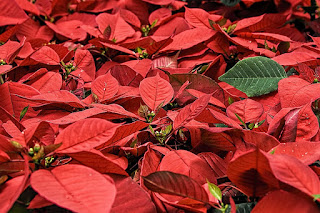by Kurt M. Jones, Chaffee County Extension Director
The holidays are behind us, but that doesn’t mean that you need to discard your poinsettias! Poinsettias often lose their color in late winter, usually by mid-March. When the plant has passed its stage of usefulness in March or April, remove the colorful bracts and part of the stem. This cutting back can be done any time from March through mid-July, depending on the desirable size and shape of the plant. Be sure to leave three or four leaves on each stem to insure sufficient photosynthesis.
During the early summer, the plant will need to be repotted into the next larger size pot. Use a well-drained potting soil, such as a blend of sphagnum peat moss, vermiculite and/or perlite. Thoroughly mixing a phosphate fertilizer with the soil at the time of repotting is a common practice.
Place the poinsettia in a bright area where the temperature will remain constant. Water as needed to keep the soil moist to the touch, and fertilize with a complete fertilizer every two to three weeks. During the summer, the plant can go outside provided it is partially shaded and temperatures don’t fall below 55 degrees F. To keep the plant well-formed, trim tall growth at six-week intervals. The last pruning should occur in late August.
Poinsettias are short-day photoperiodic plants. This means that they set buds and produce flowers as the autumn nights lengthen, blooming naturally during November or December. To flower and develop colored bracts, a poinsettia must receive as much sunshine as possible during the day. Starting about October 1st, it also needs at least 14 hours of uninterrupted darkness each night at temperatures between 60 and 70 degrees F. Stray light of any kind such as street lights, pool lights or lamps could delay or halt the reflowering process. Keep this dark treatment until color shows in the bracts. This normally happens near Thanksgiving, but could happen as early as two weeks before Thanksgiving. Continue watering and fertilizing to encourage good growth.
There are many pests that can infest poinsettias. Insects should be washed off with a mild soap solution using a sponge or spray bottle. Mealybugs and whiteflies may require a pesticide treatment or removal of infested plant parts. Mealybugs can be treated using rubbing alcohol and cotton swabs.
Cool, moist soil temperatures encourage root diseases. If lower leaves start turning yellow and fall off, a root rot condition may be present. This can be overcome by using a fungicide as a soil drench.
One common misconception with poinsettias is the fear they are poisonous. In a 1995 poll, 2 out of every 3 people held the false impression that poinsettia plants are toxic if eaten. Research conducted at Ohio State University showed that rats fed unusually high doses of poinsettia plant parts were not adversely affected. To equal this experiment, a 50-pound child would have to eat more than 500 poinsettia bracts. Based on this research, the U.S. Consumer Product Safety Commission denied a 1975 petition to label poinsettias as dangerous. Poinsettias are not edible and are not intended to be eaten. If eaten, parts of all plants may cause varying degrees of discomfort, but usually not death. Keep all plants out of the reach of small children.


No comments